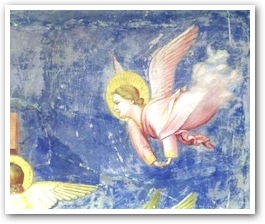The Holy Year Door
- FR. WILLIAM SAUNDERS
I watched Pope John Paul II open the Holy Door of St. Peter's on television on Christmas Eve. Could you please explain the significance of the Holy Door?
 |
Since the year 1300 when Pope Boniface VIII declared the first Holy Year, the Catholic Church has regularly celebrated "Holy Years," usually every twenty-five years (at least since 1470), except for special circumstances, like in 1983 when a Holy Year was declared to mark the 1,950th anniversary of the death and resurrection of our Lord. A major aspect of the Holy Year has been that of pilgrimage to Rome to make reparation for sin and to renew the conversion of one's life.
A very important symbolic act performed by each pilgrim has been to pass through the Holy Door. Christ identified Himself as "the door." In his bull "Incarnationis Mysterium" proclaiming this Holy Year, Pope John Paul II stated that the Holy Door "... evokes the passage from sin to grace which every Christian is called to accomplish. Jesus said, 'I am the door' (Jn 10:7) in order to make it clear that no one can come to the Father except through Him. This designation which Jesus applies to Himself testifies to the fact that He alone is the Savior sent by the Father. There is only one way that opens wide the entrance into this life of communion with God: This is Jesus, the one and absolute way to salvation. To Him alone can the words of the psalmist be applied in full truth: 'This is the door of the Lord where the just may enter' (Ps 118:20)."
Therefore to pass through the door from the outside of St. Peter's into the basilica is to pass from this world into the presence of God, just as in the old Temple of Jerusalem, the High Priest on the Feast of Yom Kippur passed through the door of the Holy of Holies to enter into the presence of God to offer the sacrifice of atonement. Moreover, to pass through the door is to confess with firm conviction that Jesus Christ is the Son of God, the Lord and the Savior who suffered, died, and rose for our salvation. With great courage, a person freely decides to cross the threshold leaving behind the kingdom of this world so as to enter the new life of grace of the Kingdom of God.
In opening the door, the Holy Father has traditionally struck the door three times with a silver hammer (although this year Pope John Paul II pushed three times on the door). The striking of the door also has symbolic meaning: Moses struck the rock so that water would pour out miraculously to quench the thirst of the people (Nm 20:6ff); the Holy Year is a time when God pours forth abundant graces to quench the thirst of our souls. God struck the earth to free Paul and Silas from prison, which resulted in the jailer and his family asking for baptism (Acts 16:25ff); God has struck our hearts opening them to His graces, beginning with the saving grace of Baptism. As our Lord hung upon the cross, the soldier struck His most Sacred Heart, and out flowed blood and water, symbols of the Holy Eucharist and Baptism (Jn 19:31f) which nourish each of our souls. In all, the striking of the door symbolizes the release of graces, flowing abundantly to the faithful.
Moreover, when the door opens, the obstacles of passage to our Lord are removed. During the Holy Year, we hope and pray that the obstacles of personal weakness, temptation and sin will be removed so that we will have a holy union with our Lord.
The construction of the door itself reminds us of the history of salvation. The door consists of 16 panels, four panels divided into four rows; the "door" itself is divided into two with two columns of panels for each door. The very top row has two panels showing the exile of Adam and Eve from the Garden of Eden after the Fall with the sword-wielding angel guarding the entrance with the fiery sword. The opposite two panels depict the Annunciation with the Archangel Gabriel asking Mary to be the Mother of Jesus. The inscription covering both panels reads, "In that sad Eve took away [paradise], you [Mary] give back with life-giving child" ("Quod Heva tristis abstulit, Tu reddis almo germine").
The next row of four panels highlight gospel stories of the mercy and forgiveness of God: First, the baptism of our Lord by St. John at the Jordan with the inscription, "You come to me?" ("Tu venis ad me? "). The second, the good shepherd finding of the lost sheep: "To save what had been lost" ("Salvare quod perierat"). Third, the prodigal son asking forgiveness from his father: "Father I have sinned against heaven and also you" ("Pater, peccavi in coelum et coram te"). Fourth, Jesus curing the paralytic, but first saying, "Your sins are forgiven": "Take your mat and walk" ("Tolle grabatum tuum et ambula").
The third row continues the same theme: First, the penitent woman washing the feet of Jesus in the home of Simon the Pharisee: "Her many sins are forgiven her" ("Remittuntur ei peccata multa"). Second, St. Peter asking our Lord how many times must a person forgive and our Lord replying, "Seventy times seven" ("Septuagies septies"). Third, Peter weeping after he had just denied our Lord three times outside the home of Caiphas the High Priest on Holy Thursday evening: "The Lord turned and looked at Peter" ("Conversus Dominus respexit Petram"). Fourth, the crucifixion, with our Lord between the two thieves, and saying to the "good thief," "Today you will be with me in paradise" ("Hodie mecum eris in paradiso").
The final row proclaims the Easter mystery and the birth of the Church: First, St. Thomas inspecting the wound marks of Jesus: "Happy are those who have believed" ("Beati qui crediderunt."). Second, Jesus appearing to the apostles on Holy Thursday night, saying, "Receive the Holy Spirit" ("Accipite Spirituum Sanctum"). Third, Jesus appearing to Saul (St. Paul) on the road to Damascus: "I am Jesus whom you are persecuting" ("Sum Jesus quem tu persequeris"). Finally, a picture of the Holy Father striking the Holy Door, "I stand at the door and knock" ("Sto ad ostium et pulso"). In all, these scenes remind us of our call as pilgrims to enter the mystery of salvation and to pass from sin to grace, from separation to union with God, and from death to eternal life.
As we being this Holy Year, our Lord stands at the door of our hearts knocking. We must open our hearts to Him and cross the threshold of hope, striving for holiness.
 This is Meaghen Gonzalez, Editor of CERC. I hope you appreciated this piece. We curate these articles especially for believers like you.
This is Meaghen Gonzalez, Editor of CERC. I hope you appreciated this piece. We curate these articles especially for believers like you.
Please show your appreciation by making a $3 donation. CERC is entirely reader supported.

Acknowledgement
Saunders, Rev. William. "The Holy Year Door." Arlington Catholic Herald.
This article is reprinted with permission from Arlington Catholic Herald.
The Author

 Father William Saunders is pastor of Our Lady of Hope parish in Potomac Falls, Virginia. He is dean of the Notre Dame Graduate School of Christendom College. The above article is a "Straight Answers" column he wrote for the Arlington Catholic Herald. Father Saunders is the author of Straight Answers, a book based on 100 of his columns, and Straight Answers II.
Father William Saunders is pastor of Our Lady of Hope parish in Potomac Falls, Virginia. He is dean of the Notre Dame Graduate School of Christendom College. The above article is a "Straight Answers" column he wrote for the Arlington Catholic Herald. Father Saunders is the author of Straight Answers, a book based on 100 of his columns, and Straight Answers II.




